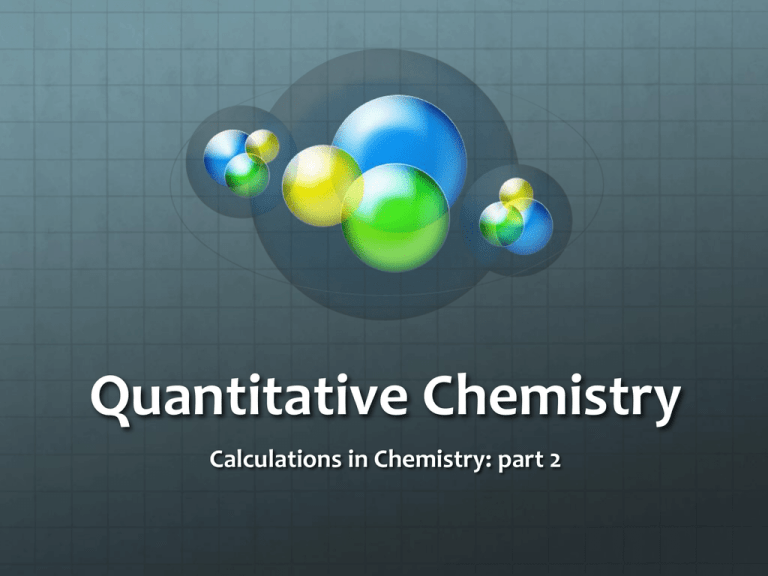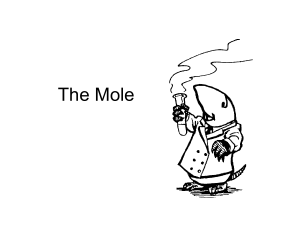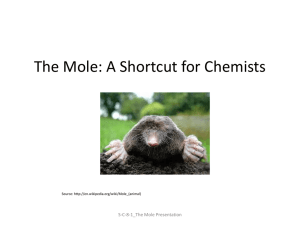File
advertisement

Quantitative Chemistry Calculations in Chemistry: part 2 Compound Formation A particular compound always contains the same elements. Independent of how you make the compound the elements are always present in the same proportion by mass. These proportions cannot be changed. Magnesium oxide always contains 60% Mg and 40% O by mass. Reacting amounts of substance Relative formula masses can also be used to calculate the amounts of compounds reacted together or produced in reactions. If 0.24g of Mg react with 0.16g of O to produce 0.40g of MgO.......... How much MgO will be produced by burning 12g of Mg? 0.24g Mg produces 0.40g of MgO so 1g of Mg produces 0.40/0.24 g of MgO = 1.67 g of MgO so 12g of Mg produces 12 x 1.67 g MgO = 20g of MgO Important Calculations of quantities like these are a very important part of chemistry. There is a great deal of information stored in the formulae and the equation. Activity Question 3 on page 181 Extension: Read through pg 178 – 179 (compound formation and chamical formulea. Answer question 4 on page 181 The Mole • When carrying out an experiment a chemist can not weigh out single atoms or molecules. • A counting unit was found. • The standard unit of a substance is the relative atomic mass in grams. • This unit is called 1 mole (1 mol) • Carbon Ar = 12 • 1 mole of carbon is 12g In a similar way banks weigh coins because they know how much one coin weighs Avogadro‘s Constant (L) 1 mole of any substance contains the same number of atoms. 6.02 x 1023 atoms per mole 6.02 x 1023 coke cans stacked together would cover the surface of the Earth to a depth of 200 miles. Calcualtions involving the Mole How to calculate the molar mass. Write the formula for ethanol C2H5OH Calcualte Mr = (2x12) + (5 x 1) + 16 + 1 = 46 • The molar mass of ethanol is 46g/mol Calculations For any given mass of a substance you can calculate the moles present. Mass Number Of Moles Mr Example How many moles are there in 60g of Sodium Hydroxide? Mr of NaOH = 23 + 16 + 1 = 40 Molar mass of NaOH = 40g /mol Number of moles = mass / molar mass = 60 / 40 = 1.5 mols Activity Worksheet 6.2 Working out the Empirical Formula We can work out the chemical formula from experimental data. Magnesium reacts with oxygen to form magnesium oxide. In an experiment if we know that 0.24g of Mg reacts with 0.16g of O2 we can determine the formula. Mg O Mass combined o.24 g 0.16g Molar mass 24 g/mol 16 g/mol Number of moles 0.01 mol 0.01 mol Simplest ratio 1 1 formula MgO Activity: Calculate the empirical formula for silicon oxide Mass Si O 47g 53g Molar mass Number of moles Simplest ration Formula Complete questions on page 185 A Chemical Footbridge: calculating reacting amounts What mass of aluminium oxide is produced when 9.2g of aluminuim metal react with oxygen? Balanced equation: 4Al + 3O2 2Al2O3 Ratio 4:2 Convert 9.2 g of Al into moles. Number of moles = mass/ molar mass = 9.2 / 27 = 0.34 mol Use the ratio from the equation to work out how many moles of Al2O3 are produced. 4 mol of Al produce 2 mol of Al2O3 So 0.34 mol of Al produce 0.17 mol of Al2O3 A Chemical Footbridge: calculating reacting amounts …..continued Work out the mass of Al2O3 Mr = 102 Mass = molar mass x number of moles = 102 x 0.17 = 17.3 g Concentrations of Solutions Two types of concentration Mass concentration - g/dm³ Molar concentration - mol / dm³ 1dm³ = 1000 cm³ = 10 cm x 10 cm x 10cm = 1 Litre Concetration = mass of solute volume of solution Concentration A 1 mol /dm³ solution of sodium chloride contains 58.5g of NaCl (1 mol) dissolved in water and made up to a final volume of 1 dm³ or 1 litre. Concentration calculations How many moles of suger are there in 500 cm³ of a 3.0 mol/dm³ sugar solution? Number of moles = concentration x volume 1000 = 3.0/ 1000 = 1.5 mol x 500 Example Calculate the concentration of a solution of sodium hydrioxide , NaOH, that contains 10g of NaOH in a final volume of 250 cm³ (= 0.25 dm³) Calculate number of moles Mr = 23 + 16 + 1 = 40 Number of moles = mass/ Mr = 10/40 = 0.25 mol Find the concentration Number of moles = concentration x volume Concentration = number of moles / volume = 0.25 / 0.25 = 1 mol /dm³ Activity Read pages 192 and 193









